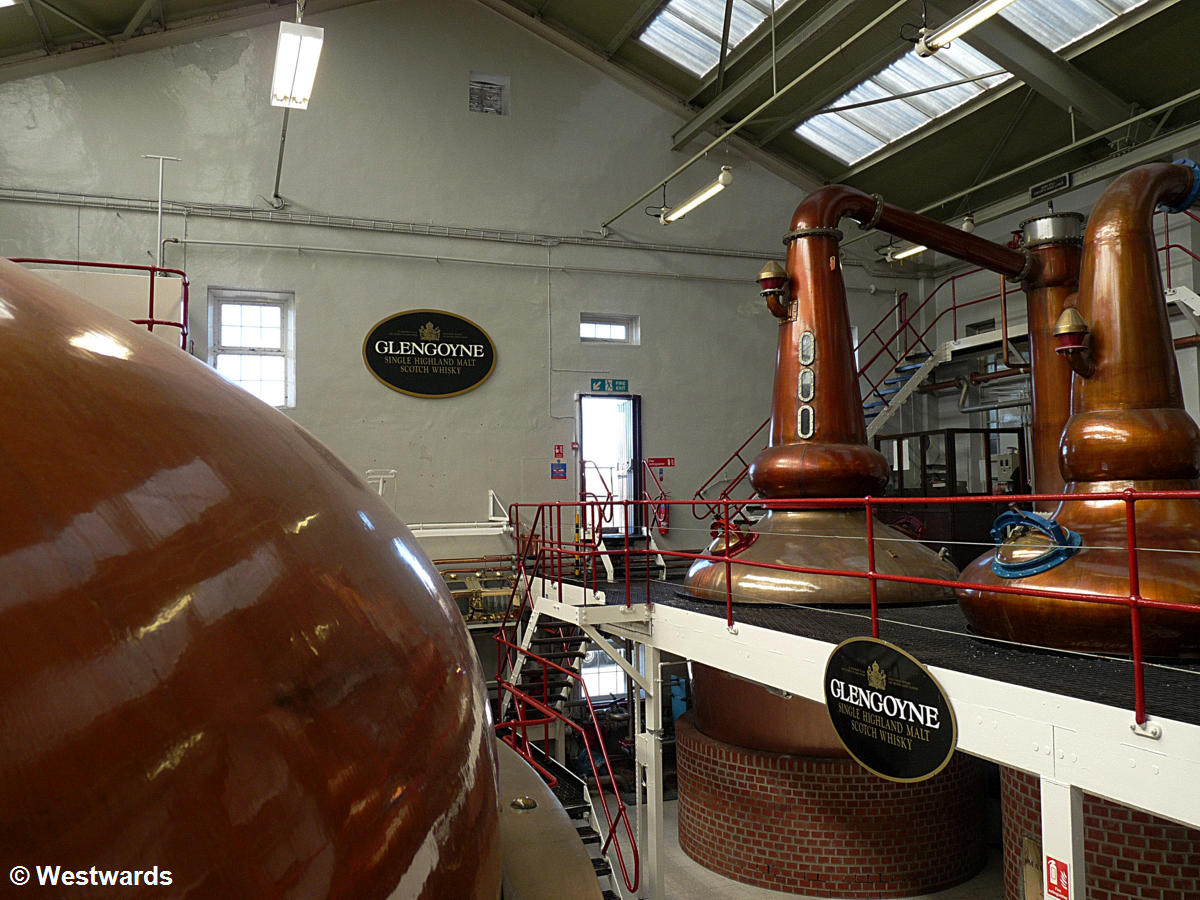
On the first hiking day of the West Highland Way the trail passes the Glengoyne Whisky Distillery. Obviously we have to stop for a visit and some tasting!
The air in the backyard between the old whitewashed buildings is filled with a peculiar smell, sweet and strong. „Where does that smell come from?,“ we ask, but Arlo, our guide, shrugs and points to a crane used to clean the copper roof of the pagoda chimney: „Maybe from the engine!“
A picturesque pagoda chimney
The chimney, he explains, is typical for the malting houses of Scottish Whisky distilleries. The chimney opening needs such a large roof because it rains so much in Scotland. In the malting house the barley used for the whisky production was first soaked in water so that it would germinate and the starch would turn into sugar. It would then be dried in order to stop it from actually sprouting. Nowadays, the Glengoyne Distillery (like most others), buys ready-malted barley and doesn’t use the malting house anymore. But it still has the picturesque pagoda chimney, which is now gleaming like new.

Arlo, who used to work in the police force for more than 20 years and now guides the tour groups through the whisky distillery, leads us into the mashing room. This is where the malted barley is simmered in water to produce sweetish malt water, called wort. “Malt storage” indicates a sign on a door we pass. And then that peculiar smell intensifies as we move on towards the fermentation tanks. In those tanks, brewer’s yeast is added to the wort. The mixture bubbles ferociously in the tanks, turning the sugar into alcohol. “This is basically a strong beer, only without hop,” explains Arlo. And we realise that after several years of working at the Glengoyne whisky distillery he probably doesn’t even notice the peculiar smell any more.

Beer at the Glengoyne whisky destillery?
“Beer?!” The group of Russians who have belatedly joined the tour take notice. But Arlo insists that this strong beer with around 8% of alcohol doesn’t taste well.
The beer is only a means of getting an alcoholic liquid from which to distil the actual whisky. They heat it to just over 78°C, at which point the alcohol content boils and evaporates. The steam then cools down and drips into a tank for another round of distillation. The outcome of all of this is an unimpressive clear liquid, Arlo shows us.

“And at this stage it is not yet whisky – you may only call it whisky after at least three years of maturation in an oak cask.”
It is this cask, which had previously been filled with Bourbon or Sherry, that gives the whisky its golden colour.

And of course the tour ends with a glass of 12-year-old single malt Glengoyne whisky. In the shop we buy another tiny bottle of their 15-year-old and a small package of whisky fudge – both of which we cherish in the following wet and windy hiking days on the West Highland Way.
Interested in Whisky? See also our posts on the Japanese Whisky distilleries of Suntory and Nikka and about our tour to eight whisky distilleries on Islay, Scotland. Or try a very similar distilled spirit: The Awamori in Okinawa is made from rice, but has a similarly heavy bouquet.
Tours at the Glengoyne Whisky Distillery
NB: We had no sponsoring for this post about the Glengoyne Whisky Distillery. We walked the West Highland Way all on our own and paid for the tasting tour. This post does not contain affiliate links.
Never miss a new post! Get notifications about new posts straight into your inbox!



